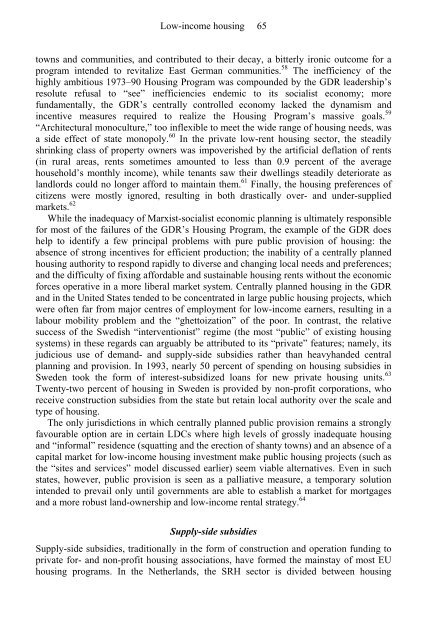Rethinking the Welfare State: The prospects for ... - e-Library
Rethinking the Welfare State: The prospects for ... - e-Library
Rethinking the Welfare State: The prospects for ... - e-Library
Create successful ePaper yourself
Turn your PDF publications into a flip-book with our unique Google optimized e-Paper software.
Low-income housing 65<br />
towns and communities, and contributed to <strong>the</strong>ir decay, a bitterly ironic outcome <strong>for</strong> a<br />
program intended to revitalize East German communities. 58 <strong>The</strong> inefficiency of <strong>the</strong><br />
highly ambitious 1973–90 Housing Program was compounded by <strong>the</strong> GDR leadership’s<br />
resolute refusal to “see” inefficiencies endemic to its socialist economy; more<br />
fundamentally, <strong>the</strong> GDR’s centrally controlled economy lacked <strong>the</strong> dynamism and<br />
incentive measures required to realize <strong>the</strong> Housing Program’s massive goals. 59<br />
“Architectural monoculture,” too inflexible to meet <strong>the</strong> wide range of housing needs, was<br />
a side effect of state monopoly. 60 In <strong>the</strong> private low-rent housing sector, <strong>the</strong> steadily<br />
shrinking class of property owners was impoverished by <strong>the</strong> artificial deflation of rents<br />
(in rural areas, rents sometimes amounted to less than 0.9 percent of <strong>the</strong> average<br />
household’s monthly income), while tenants saw <strong>the</strong>ir dwellings steadily deteriorate as<br />
landlords could no longer af<strong>for</strong>d to maintain <strong>the</strong>m. 61 Finally, <strong>the</strong> housing preferences of<br />
citizens were mostly ignored, resulting in both drastically over- and under-supplied<br />
markets. 62<br />
While <strong>the</strong> inadequacy of Marxist-socialist economic planning is ultimately responsible<br />
<strong>for</strong> most of <strong>the</strong> failures of <strong>the</strong> GDR’s Housing Program, <strong>the</strong> example of <strong>the</strong> GDR does<br />
help to identify a few principal problems with pure public provision of housing: <strong>the</strong><br />
absence of strong incentives <strong>for</strong> efficient production; <strong>the</strong> inability of a centrally planned<br />
housing authority to respond rapidly to diverse and changing local needs and preferences;<br />
and <strong>the</strong> difficulty of fixing af<strong>for</strong>dable and sustainable housing rents without <strong>the</strong> economic<br />
<strong>for</strong>ces operative in a more liberal market system. Centrally planned housing in <strong>the</strong> GDR<br />
and in <strong>the</strong> United <strong>State</strong>s tended to be concentrated in large public housing projects, which<br />
were often far from major centres of employment <strong>for</strong> low-income earners, resulting in a<br />
labour mobility problem and <strong>the</strong> “ghettoization” of <strong>the</strong> poor. In contrast, <strong>the</strong> relative<br />
success of <strong>the</strong> Swedish “interventionist” regime (<strong>the</strong> most “public” of existing housing<br />
systems) in <strong>the</strong>se regards can arguably be attributed to its “private” features; namely, its<br />
judicious use of demand- and supply-side subsidies ra<strong>the</strong>r than heavyhanded central<br />
planning and provision. In 1993, nearly 50 percent of spending on housing subsidies in<br />
Sweden took <strong>the</strong> <strong>for</strong>m of interest-subsidized loans <strong>for</strong> new private housing units. 63<br />
Twenty-two percent of housing in Sweden is provided by non-profit corporations, who<br />
receive construction subsidies from <strong>the</strong> state but retain local authority over <strong>the</strong> scale and<br />
type of housing.<br />
<strong>The</strong> only jurisdictions in which centrally planned public provision remains a strongly<br />
favourable option are in certain LDCs where high levels of grossly inadequate housing<br />
and “in<strong>for</strong>mal” residence (squatting and <strong>the</strong> erection of shanty towns) and an absence of a<br />
capital market <strong>for</strong> low-income housing investment make public housing projects (such as<br />
<strong>the</strong> “sites and services” model discussed earlier) seem viable alternatives. Even in such<br />
states, however, public provision is seen as a palliative measure, a temporary solution<br />
intended to prevail only until governments are able to establish a market <strong>for</strong> mortgages<br />
and a more robust land-ownership and low-income rental strategy. 64<br />
Supply-side subsidies<br />
Supply-side subsidies, traditionally in <strong>the</strong> <strong>for</strong>m of construction and operation funding to<br />
private <strong>for</strong>- and non-profit housing associations, have <strong>for</strong>med <strong>the</strong> mainstay of most EU<br />
housing programs. In <strong>the</strong> Ne<strong>the</strong>rlands, <strong>the</strong> SRH sector is divided between housing


